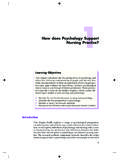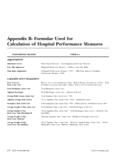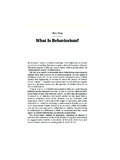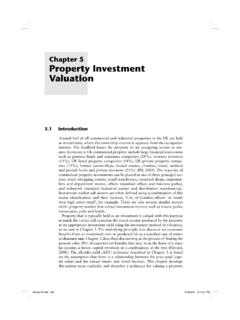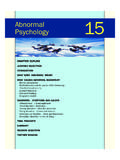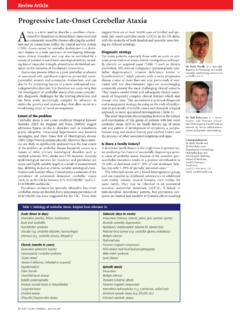Transcription of Chapter 13 Organic psychiatric disorders - Wiley-Blackwell
1 PSY13 1/26/05 6:57 PM Page 136. Chapter 13. Organic psychiatric disorders Organic psychiatric disorders are those with Dementia demonstrable pathology or aetiology, or which arise directly from a medical disorder. They are Clinical features of dementia thereby distinguished from all other psychiatric disorders , which are traditionally called functional. Review the core and module approach to assess- This distinction is an oversimplification and con- ment of dementia ( Chapter 2 and 3). ceptually flawed as all disorders have biological, Dementia is also known as chronic brain syndrome. psychological and social contributions ( Chapter Its cardinal feature is memory impairment (short- 1). The term causes both practical and semantic term worse than long-term) without impaired problems, but remains in widespread use and so is consciousness (cf. delirium). The overall clinical used here: profile differs depending on the specific type of The major Organic disorders , dementia and deliri- dementia, as outlined below, but other common um, are defined, like other psychiatric syndromes, features of dementia are: by their characteristic clinical features.
2 However, Symptoms present for 6 months, of sufficient unlike other syndromes they are known to arise severity to impair functioning. from different diseases with various aetiologies Personality and behavioural change and pathologies. A complete diagnosis requires the wandering, aggression, disinhibition. disease as well as the dementia syndrome to be Dysphasias, dyspraxias and focal neurological identified. signs may be present. Other Organic disorders are simply psychiatric Psychotic symptoms in half of cases at some disorders of any type that appear, in a particular stage. case, to be caused by an identifiable medical condi- Unawareness of deficits (except early on). tion. Sometimes it is the psychiatric symptoms Nearly always progressive (though this is not a that first bring the person to medical attention. diagnostic criterion). Substance misuse disorders are Organic , in that The incidence of dementia rises rapidly with there is a specific pharmacological cause.
3 By con- age, affecting <5% of 65 year olds and 20% of vention they are classified separately ( Chapter 14). 80 year olds. (Exact figures depend on severity psychiatric disorders which are considered psy- threshold.) The risk of dementia is doubled chological reactions to illness such as becoming in those with an affected first-degree relative. depressed after being told you have cancer are ex- Other risk factors depend on the type of dementia cluded from the Organic category. concerned. 136. PSY13 1/26/05 6:57 PM Page 137. Organic psychiatric disorders Chapter 13. The rapid rise with age is typified by Alzheimer's Late-onset schizophrenia (paraphrenia). Check for disease (Figure ). prominent symptoms of psychosis. Dementia in the under 65 s is termed presenile dementia. The causes of dementia The common dementias are listed in Table Differential diagnosis of dementia Alzheimer's disease accounts for over half of all Established dementia is usually unmistakeable, but cases, with the majority of the rest explained by mild dementia can be confused with (or coexist vascular dementia and Lewy body dementia.)
4 With) other conditions: The syndromes are not mutually exclusive, and Depression. Poor concentration and impaired the common ones often coexist. memory are common in depression in the elderly, In presenile dementia, a higher percentage of hence pseudodementia. Two factors which help dis- cases are due to rare genetic disorders or severe tinguish depression from dementia are: Did low head injury. mood or poor memory come first? Is the failure to answer questions due to lack of ability or lack of Clinical features differentiating motivation? the dementias Delirium. See next section. Deafness. Check the person can hear. Careful clinical evaluation identifies the specific Dysphasia. Check they can understand and dementia in more than 80% of cases (Table ). speak. A distinction is sometimes made clinically Amnesic syndrome. A purer short-term memory between cortical dementia ( Alzheimer's dis- defect (see below).
5 Ease) and subocortical dementia ( Huntington's 600. 500. Women Cases of Alzheimer's Disease per 1000. 400. 300. Men 200. 100. 0. Figure The prevalence of Alzheimer's disease with ageing. 65 69 70 74 75 79 80 84 85 89 90 94 95. Adapted from Nussbaum RL, Ellis CE. Age (year). New Engl J Med 2003, 348, 1356 64. 137. PSY13 1/26/05 6:57 PM Page 138. Chapter 13 Organic psychiatric disorders Table Causes of dementia. clues, further tests in an elderly person rarely change the diagnosis, let alone reveal a reversible Alzheimer's disease (50 60% of cases). cause. Vascular dementia (20 25%) Conversely, in a young person, every effort is Dementia with Lewy bodies (10 15%) made to make a diagnosis not only in case it is treatable and to inform prognosis, but because the Other causes (<10%). dementia may well be inherited and genetic testing Degenerative disorders Frontotemporal dementia available for the family.
6 Presenile dementia is Pick's disease usually referred to neurologists. Huntington's disease Prion disease Management of dementia Progressive supranuclear palsy Metabolic disorders Occasionally, dementia is potentially reversible Alcoholic dementia ( space occupying lesion; B12 deficiency) and Vitamin B12 deficiency responds to appropriate treatment. Specific inter- Infections ventions to treat symptoms in Alzheimer's disease HIV. are also now available, as discussed below. How- Syphilis ever, the management of dementia generally has Other causes Normal pressure hydrocephalus more modest goals, the main one being to opti- Intracranial tumours mize quality of life for patient and carer. Whatever Subdural haematoma the cause of the dementia, the following principles Head injury and strategies are important: Think about the patient, their environment, and their carers as potential targets for intervention.
7 Disease) (Table ). However, it is better to try and Characterize and treat the non-cognitive abnor- make a specific diagnosis (and the terms are mis- malities. Simple interventions can improve prob- leading as most dementias affect both brain lems such as wandering ( by regular exercise or regions). raising the door handle) and incontinence ( The disorders themselves are discussed in the by a toiletting routine). Non-pharmacological next section. methods should always be employed first. Psychotic symptoms respond to low-dose antipsychotics. They should be used sparingly and Assessment of dementia for brief periods only, because psychosis in demen- In the history and examination, look for clues tia is usually transient, and because they are associ- pointing towards one of the diagnoses in Table ated with more rapid cognitive decline and with For example, a history of a fall (?subdural sudden death, especially in Lewy body dementia.
8 Haematoma) or incontinence (?normal pressure Atypical antipsychotics may also increase risk of hydrocephalus), rapid fluctuations (?dementia stroke. with Lewy bodies); on examination you might find Antipsychotics should not be used for non- hypertension and a carotid bruit (?vascular demen- specific behavioural problems or to sedate people tia). Table shows the baseline and specialized with dementia. tests used in the investigation of dementia. Treat depression. SSRIs are better tolerated than Only the baseline blood tests would routinely be tricyclics. ordered, with further investigation depending on A range of other interventions are also some- the age of the patient and the suggestion of a treat- times used, including reality orientation, lavender able aetiology (for example, a scan to exclude a oil aromatherapy, carbamazepine, reminiscence subdural haematoma). In the absence of such therapy, music therapy, art therapy, and memory 138.
9 PSY13 1/26/05 6:57 PM Page 139. Organic psychiatric disorders Chapter 13. Table Clinical features distinguishing between the dementias. Prominent symptoms and signs Other clinical features Alzheimer's disease Memory loss, especially short-term Relentlessly progressive Dysphasia and dyspraxia Survival 5 8 years Sense of smell impaired early Behavioural changes, Psychotic symptoms at some stage Vascular dementia Personality change Stepwise progression Labile mood Signs of cerebrovascular disease Preserved insight History of hypertension Commoner in men, smokers Dementia with Lewy bodies Fluctuating dementia Antipsychotics worsen condition Delirium-like phases Parkinsonism Visual hallucinations Frontotemporal dementia Stereotyped behaviours Slowly progressive Personality change Family history common Early loss of insight Commoner in women Expressive dysphasia Onset usually before age 70.
10 Memory relatively preserved Early primitive reflexes Huntington's disease Schizophrenia-like psychosis Presents in the 20s 40s Abnormal movements (choreiform) Strong family history Depression and irritability Dementia occurs later Normal pressure hydrocephalus Mental slowing, apathy, inattention Commonest in 50 70 year olds Urinary incontinence Commonest reversible dementia Problems walking (gait apraxia). Prion disease Myoclonic jerks Often presenile Seizures Rapid onset and progression Cerebellar ataxia Death within a year Table Clinical features of subcortical versus cortical training. There is some evidence that the first three dementias. may be beneficial for behavioural problems. Social interventions such as meals-on-wheels, Subcortical Cortical dementia dementia day care and respite admissions help carers cope. Investigate any sudden deterioration. It may Memory loss Moderate Severe, early be due to a treatable cause ( superimposed Language Normal Affected delirium due to a UTI).




